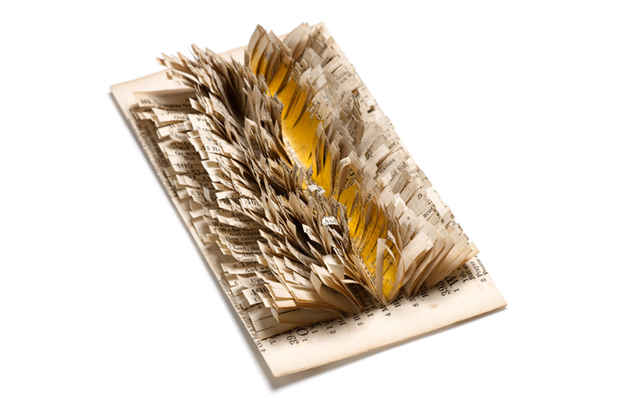Carole P. Kunstadt "The Sacred Poems"
Galleries at the Interchurch Center

This event has ended.
The Sacred Poems series takes physical, material, and intellectual inspiration from Parish Psalmody, A Collection of Psalms and Hymns for Public Worship, published in 1844.
The primary element used in this series is paper: the pages are taken from a Parish Psalmody dated 1844. These pages of psalms are manipulated and recombined, resulting in a presentation that evokes an ecumenical offering: poems of praise and gratitude. The disintegrating pages suggest the temporal quality of our lives and the vulnerability of memory and history. In working with this aged text, embracing its inherent qualities while transforming the book’s pages, the paper itself gains significance through the process and merges with a new intent.
Visually there is a consistent and measured cadence to a page of psalms which is echoed in the repetitive weaving or restructuring of the paper: pages are cut in strips and woven creating an altered dense surface; multiple pages are stitched together and the shredded edges form new textural references; the layering of translucent tissue over the paper softens the effect of age and context, evoking the ephemeral while adding a veil of alternative possibilities. Although fragile, the paper is surprisingly resilient. In a number of the pieces the use of stitching emphasizes the repetition of the lines of text. The lines of stitching are suggestive of the passage of time, alluding to the age and the history contained within. The continuing repetitive action of sewing is similar to reciting, singing, and reading: implying that through the repetition of a task or ritual one has the possibility to transcend the mundane. Explored and displayed in this visual context, the alteration of the papers’ linear, tactile, and facile nature emphasizes transformation, while the possibility of revelation is playfully realized.
The intended use, as well as the nature of a psalm as spiritual repository, both imply a tradition of careful devotion and pious reverence. The physical text evocatively and powerfully serves as a gateway to an experience of the sacred and the realization of the latent power of the written word. This process of interaction is played out visually in the piece, mimicking the internal experience. Thus, through the individual evolution of each page, culminating in a transformation of the whole volume, the material and the conceptual interface delicately and suggestively with one another.
“A sense of intimacy and loss pervades the work; fragments of memory and belief are brought together to create a hybrid form that negates the sequential nature of reading, replacing it with suggestive echoes of inner states of praise, worship, and prayer.”
David Revere McFadden, Slash:Paper Under the Knife.
BIOGRAPHY:
Carole P. Kunstadt received her BFA from the Hartford Art School, West Hartford, Connecticut, concentrating in two-dimensional studies, and went on to postgraduate studies at the Akademie der Bildenen Künste, Munich, Germany. Her interest in tapestry design and weaving led to an assistantship in the tapestry studio of Helena Hernmarck. With Janet Kennedy, she founded Kennedy/Kunstadt Tapestries in 1981; which was commissioned by Gloria F. Ross to weave a tapestry after the Helen Frankenthaler painting “This Day”.
Media
Schedule
from September 19, 2011 to October 21, 2011
Reception For The Artist on 2011-09-29 from 16:00 to 19:00